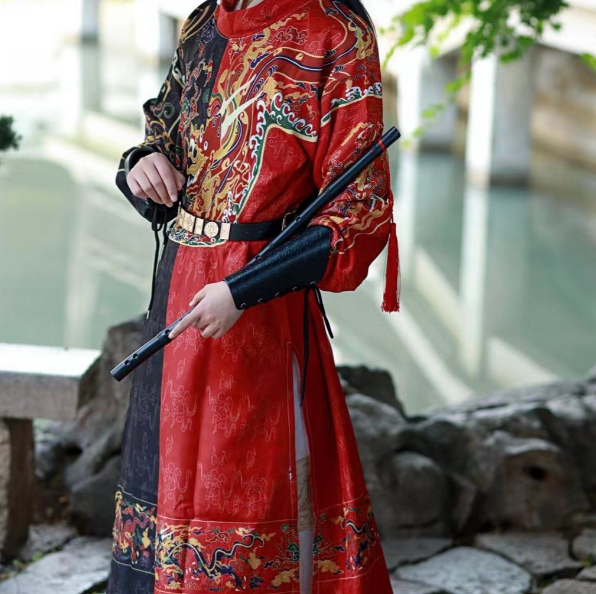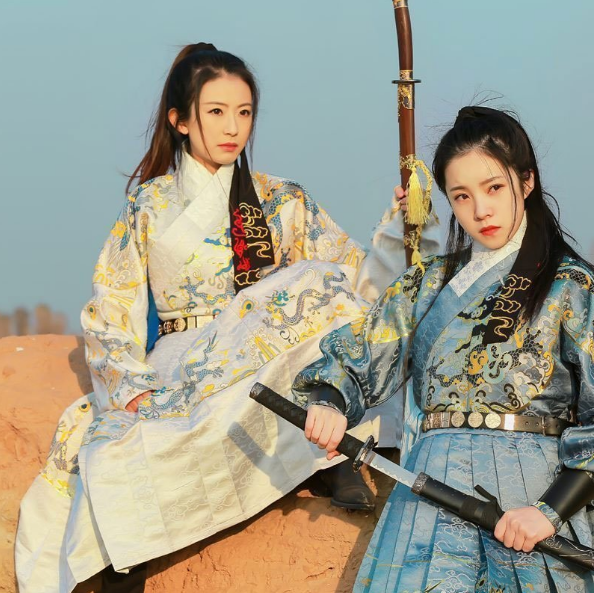Historical Context of Flying Fish Suits
Flying Fish Suits, originating from a rich historical background, emerged as significant cultural artifacts, reflecting the values and aesthetics of their time. This attire symbolizes a blend of tradition, power, and artistry, deeply rooted in the history of its originating dynasty.
Origin and Significance
The Flying Fish Suit traces its origins to a time of cultural and political prosperity. Crafted for the elite, it served as a symbol of status and authority. The choice of materials, colors, and designs in these suits not only showcased the wearer’s rank but also reflected the artistic trends and cultural values of the era. Each element of the suit, from the fabric to the motifs, was deliberately chosen to convey specific messages about power, prosperity, and societal order.

Use in Ancient Ceremonies
In ancient ceremonies, the Flying Fish Suit played a crucial role, often worn by high-ranking officials during significant events. Its presence in these ceremonies underlined the wearer’s importance and contributed to the grandeur of the occasion. The suit’s elaborate design and symbolic elements made it a perfect fit for these events, where visual representation of status and authority was paramount.
Role of Eunuchs in the Dynasty
Eunuchs, occupying a unique position within the dynasty, played crucial roles that went beyond traditional servitude, balancing administrative responsibilities and court politics. Their influence often extended into the realm of political decision-making, reflecting their complex and multifaceted role in the royal court.
Position and Duties
Eunuchs, serving in various capacities, managed palace affairs and sometimes acted as confidants and advisors to the royalty. Despite their lack of familial connections, a trait considered advantageous in the court, they wielded considerable influence in the political arena. Their roles, pivotal in maintaining the court’s balance of power, ranged from overseeing daily administrative tasks to participating in high-level political strategies.
Clothing and Symbols of Status
The clothing of eunuchs, though more understated than the nobles’ flamboyant attire, carried distinct symbols reflecting their status and roles. These symbols, often intricately embroidered on their robes, indicated their rank and duties within the palace hierarchy. The subtlety of their attire served as a reminder of their significant yet sensitive position within the complex social and political fabric of the court.
Comparison of Attires: Eunuchs vs. Nobility
A comparison between the attires of eunuchs and nobility reveals stark contrasts, highlighting the nuanced social hierarchy and cultural norms of the era. While both played significant roles in the court, their clothing distinctly mirrored their positions and functions.
Distinctive Features of Eunuch Attire
Eunuch attire, typically more modest and functional, was designed to signify their service-oriented role in the court. Their garments, often made of high-quality but less ostentatious materials, lacked the flamboyant embellishments seen in noble attire. The colors were usually muted, and the designs simpler, yet they often featured subtle symbols or emblems indicating their specific roles or ranks within the palace.
Comparison with Noble Garments
In contrast, noble garments were lavish and ornate, designed to display wealth, power, and status. They frequently used luxurious materials like silk and incorporated elaborate designs, vibrant colors, and significant embellishments. The nobility’s clothing often included intricate embroidery and jewels, reflecting their high status and the opulence of their lifestyle. This stark difference in attire between eunuchs and nobility visually represented the distinct social strata and roles within the court.
Symbolism in Ancient Clothing
Symbolism in ancient clothing was not just about style; it conveyed messages about status, beliefs, and cultural values. These garments served as a visual language, communicating intricate details about the wearer and their place in society.
Symbolic Meanings in Eunuch Garments
Eunuch garments, often more subdued than those of the nobility, carried symbols reflecting their unique roles. The use of specific colors, patterns, and motifs subtly indicated their position and function within the court. For instance, certain symbols on their attire might denote their allegiance to a particular royal figure or their role in palace rituals, encapsulating their status in a sophisticated, understated manner.
Significance of Symbols in Flying Fish Suits
The Flying Fish Suit, on the other hand, was replete with rich symbolism. Every aspect, from the color to the motifs, conveyed specific meanings. The flying fish itself, often a central motif, symbolized agility and prosperity, while other elements like dragons or phoenixes represented power and rebirth. These suits were a vivid tapestry of cultural and political significance, reflecting the high status of the wearer and the artistic trends of the era.
Cultural and Societal Implications
The clothing choices in the dynasty, including those of eunuchs and nobility, reflect broader cultural and societal implications. They serve as a mirror to the values, traditions, and social structures of the time, offering a vivid insight into the historical context.
Social Hierarchy and Clothing
Clothing in this period was a clear indicator of social hierarchy. The elaborate and luxurious attire of nobles contrasted sharply with the more functional and modest clothing of eunuchs. This distinction in dress visually reinforced the social order, delineating the roles and statuses of different classes within the society. The choice of fabric, color, and design in clothing played a crucial role in symbolizing one’s position and authority.

Cultural Perception of Eunuchs and Their Attire
The attire of eunuchs also shaped and reflected their cultural perception. Their clothing, while less ornate, carried a certain dignity and subtlety that aligned with their roles as trusted servants and advisors. The society viewed eunuchs through the lens of their attire, which, despite its simplicity, commanded respect and indicated their indispensable role in the palace and court affairs.
Evolution and Modern Interpretations
The journey of the Flying Fish Suit from its historical roots to modern interpretations showcases an evolution in its significance and perception. This transition reflects changing cultural values and artistic expressions over time.
Changes in the Significance of Flying Fish Suits Over Time
Originally, the Flying Fish Suit symbolized status and authority within a specific cultural and historical context. Over time, its significance has shifted, transforming into a symbol of historical interest and artistic inspiration. Today, it represents a connection to a rich cultural past, often studied for its craftsmanship and historical value rather than its original social symbolism.
Contemporary Representations and Misconceptions
In contemporary culture, the Flying Fish Suit often appears in art, fashion, and media, sometimes leading to misconceptions about its original use and significance. Modern interpretations can vary, ranging from accurate historical representations to creative adaptations that blend traditional elements with contemporary designs. These interpretations, while adding to the suit’s allure, occasionally perpetuate inaccuracies about its original purpose and the context in which it was worn.